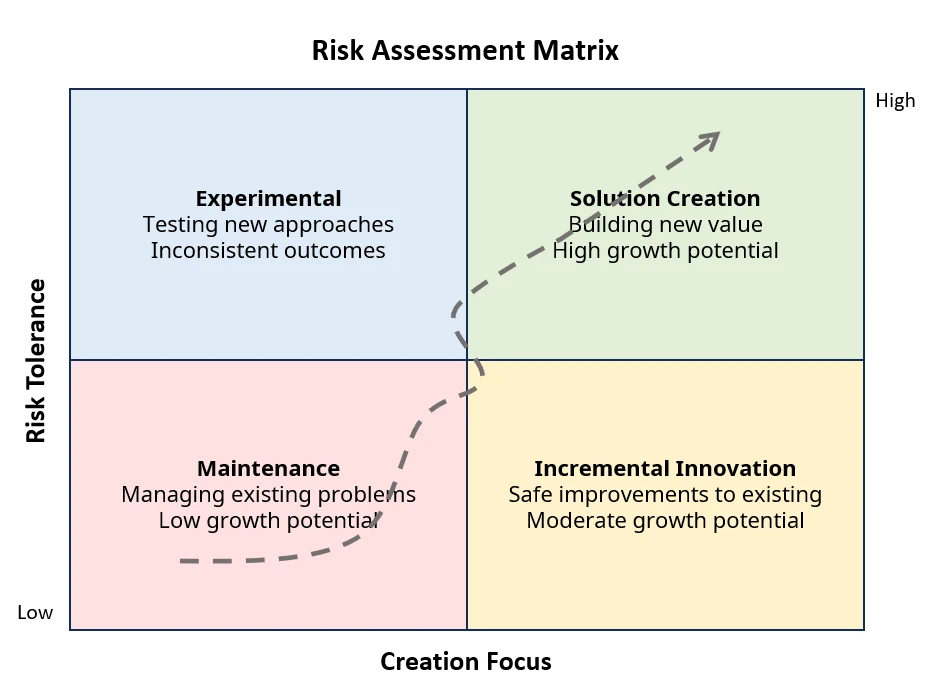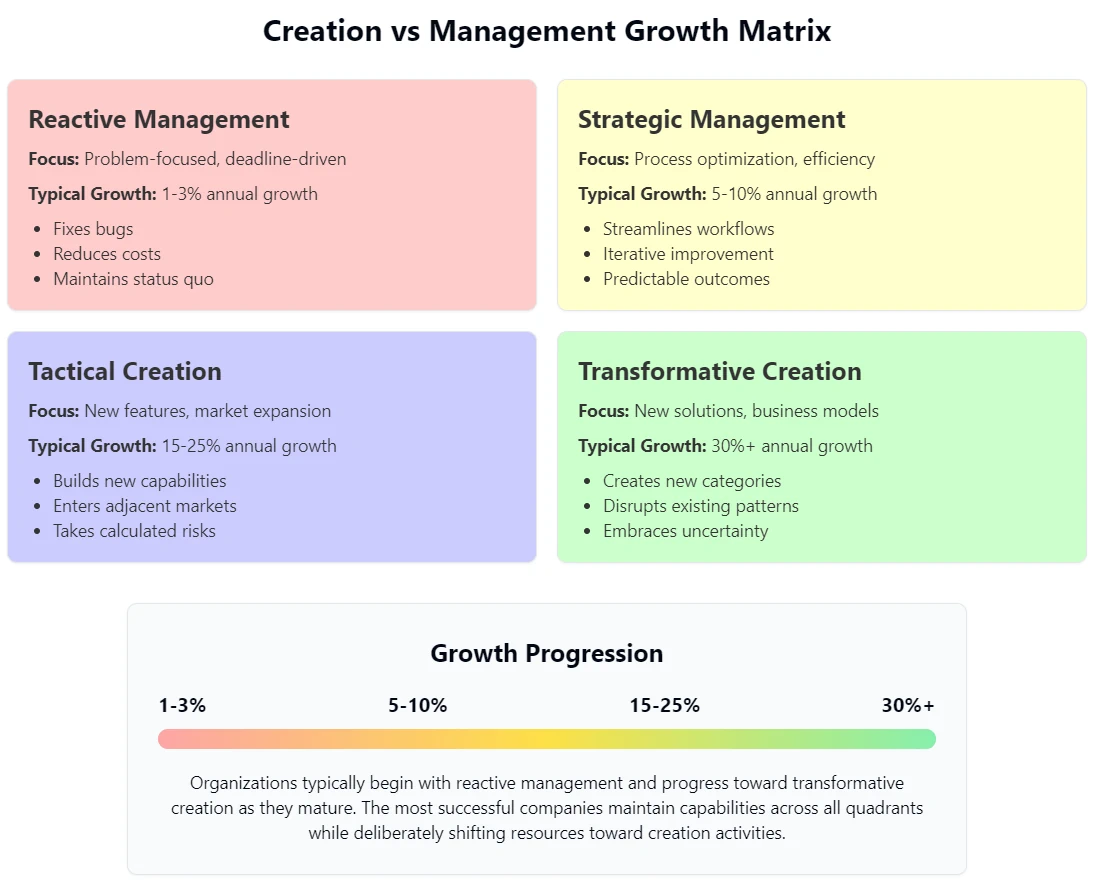Creating Solutions vs. Managing Problems
Success requires overcoming our natural tendency to protect what we have to focus on creating more of what we seek.

The Creator’s Mindset in a Risk-Averse World
According to a 2024 McKinsey survey on business innovation, 78% of executives acknowledge their organizations spend more time managing existing problems than creating new solutions. The same study found that companies prioritizing creation over management experienced 3.2× the growth rate of their protection-focused peers.
As humans, we’re wired to protect what we have. Our brains evolved to prioritize loss prevention over gain acquisition—-a phenomenon behavioral economists call loss aversion. But this tendency creates a paradox for modern businesses: the more energy we invest in protecting what we have, the less energy we devote to creating what could be.
In today’s dynamic business landscape, this creation-management balance determines which companies thrive and which merely survive. Let’s examine how this principle applies whether you’re developing a product, leading a team, or scaling a business.
The Protection Trap
I’ve witnessed countless product teams fall into what I call the “protection trap”-—devoting their best talent and resources to maintaining existing offerings while treating innovation as a side project.
This manifests in several common behaviors:
- Perfectionism disguised as quality control
- Incremental improvements that avoid meaningful risk
- Excessive focus on competitor features rather than customer problems
- Fear-based decision making (“What if our customers leave?”)
- Resource allocation that favors maintenance over innovation
I experienced this firsthand early in my career, when I led a SaaS product in the productivity space. The teams were so concerned about maintaining our existing customer base that we started saying “yes” to every feature request from our largest clients. Soon, our roadmap became a reactive wish list rather than a strategic growth plan. Our product became bloated, our development cycles slowed, and our team burned out trying to maintain increasingly complex systems.
The irony? We still lost customers—-not because we failed to implement their requests, but because our product lost its coherent vision while more focused competitors outpaced our innovation.
Growth Through Strategic Risk Assessment
The solution isn’t abandoning management entirely-—it’s reframing how we think about growth and risk. Here’s the framework I’ve found most effective:
Most companies operate primarily in the top-left quadrant (maintenance mode) with occasional ventures into incremental innovation. But sustainable growth requires intentional movement toward the bottom-right quadrant, where true solution creation happens.
This strategic shift requires two key mindset changes:
1. Stop Trying to Please Everyone
Product and business leaders often fall into the trap of trying to retain every customer. This fear-based approach leads to defensive decision-making that hampers innovation.
Instead, recognize that customer turnover is not just inevitable—-it’s sometimes beneficial. As Product-Led Growth advocate Wes Bush puts it: “The right customers accelerate your flywheel; the wrong ones create drag.”
When we evaluated our product strategy at my previous company, we realized we were contorting our roadmap to accommodate a small segment of legacy customers who represented only 8% of our revenue but consumed 70% of our support resources. By refocusing on our core value proposition and ideal customer profile, we experienced a 5% immediate customer attrition—-but a 32% growth in new, better-fit customers over the following two quarters.
The key insight: You can’t please everyone, so stop fearing customer departure and focus on attracting the right customers.
2. Create More Than You Protect
Innovation requires creating substantially more opportunities than you need, knowing many will fail. This abundance mindset shifts focus from avoiding failure to generating enough successes.
As Teresa Torres advocates in her Continuous Discovery framework, teams should explore multiple solutions for each opportunity and multiple opportunities for each outcome. This approach ensures you’re creating enough viable paths to success rather than perfecting a single solution.
For technology products, this creation mindset scales across multiple dimensions:
- Product features: Build, test, and iterate on multiple approaches
- Acquisition channels: Experiment with diverse customer acquisition strategies
- Pricing models: Test various monetization approaches
- Market segments: Explore adjacent or entirely new markets
The organizations achieving exponential growth in 2025 aren’t necessarily better at execution—they’re simply creating more options and opportunities than their competitors.
Aligning Creation with Measurable Growth
Creation without direction can lead to wasted resources and scattered focus. The most successful product teams connect their creation efforts directly to specific, measurable outcomes.
According to recent research from Petra Wille, high-performing product organizations maintain a clear line of sight between creative activities and key performance indicators. In her 2024 study of 150+ product teams, those with explicit creation-to-measurement frameworks outperformed their peers by 47% on key growth metrics.
This matrix illustrates how an organization’s focus affects growth potential. Moving from reactive management toward transformative creation correlates with significantly higher growth rates, but requires different capabilities and mindsets.
Here’s how you can implement this approach:
Identify your primary growth lever
- Is it user acquisition, retention, monetization, or virality?
- Different growth stages require different creation priorities
Design your creation portfolio
- Allocate resources according to potential impact (70% incremental, 20% adjacent, 10% transformational)
- Establish clear success metrics for each initiative
Implement rapid learning cycles
- Set maximum time-to-learning thresholds for initiatives
- Celebrate learning even when specific solutions fail
Prioritize creation velocity
- Measure the rate of new solution generation
- Remove obstacles that slow your creation flywheel
For example, if user acquisition is your primary growth constraint, your creation portfolio might focus on entry-point experiences, onboarding flows, and viral loops with explicit KPIs tied to conversion and acquisition costs.
The Path Forward: From Managing to Creating
The shift from problem management to solution creation doesn’t happen overnight. It requires intentional practice and cultural reinforcement. Here are tactical steps to begin this transformation:
Audit your calendar and resources
- Track how much time your team spends on creation vs. maintenance
- Aim for at least 40% of resources dedicated to new solution development
Implement creation rituals
- Schedule regular ideation sessions focusing on specific outcome areas
- Create safe spaces for exploration without immediate implementation pressure
Reward learning, not just success
- Develop metrics that capture insights gained, not just solutions shipped
- Celebrate well-designed experiments even when they disprove hypotheses
Build creation capabilities
- Train teams in rapid prototyping and experimentation techniques
- Develop systems for capturing and leveraging insights from creation activities
Sachin Rekhi’s work on experimentation culture emphasizes the competitive advantage of efficient idea generation and testing. Put simply, organizations that can systematically create and evaluate more potential solutions gain a significant edge over their competitors. This is the essence of the creation-focused mindset.
Conclusion: Creation as Competitive Advantage
In 2025, the most significant differentiator between thriving and struggling organizations isn’t technology, talent, or even funding—it’s the ratio of creation to management activities. Companies that systematically shift this ratio in favor of creation develop an inherent competitive advantage.
Whether you’re launching a startup, managing a product line, or leading an enterprise transformation, the principle remains the same: Stop managing problems and start creating solutions. The market rewards creation at scale, and the organizations that master this approach build sustainable growth engines that compound over time.
What’s your creation-to-management ratio today? And more importantly—what will you create tomorrow?










